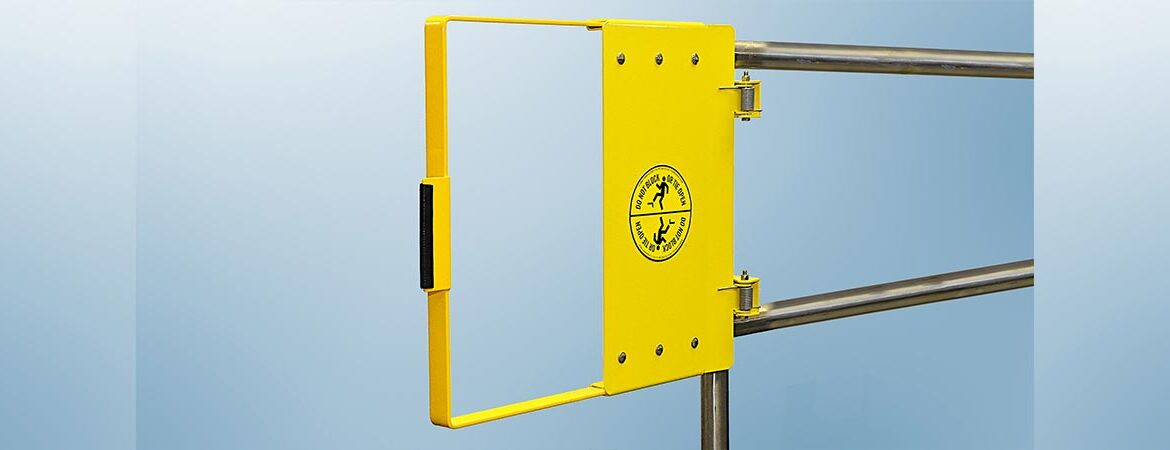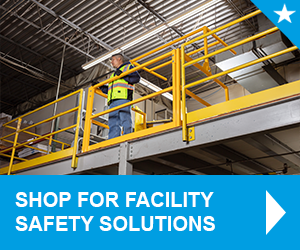
Even if your guardrails fulfill their intended function 99% of the time, that one exception may relate to poor accessibility. The right swinging safety gate (i.e. commercial swing gate) is usually the safest and most effective means of controlling access from either side of guardrail or similar barrier. Advanced swing gates even feature part-automatic functioning, maintaining a closed barrier that operates as an extension of your handrail when closed.
Numerous OSHA work safety standards require a secure means of accessing controlled areas. While a self-closing safety gate is usually just one of several possible options, it’s usually the preferred one.
What Makes an Effective Swinging Safety Gate?
At its simplest, a standard swinging safety gate is a hinged gate that generally opens freely in one or both horizontal directions. More advanced designs can include innovative functions like:
- An optional positive-stop mechanism
- Spring-loaded self-closing operation
- Near-universal mounting mechanisms
- Left or right side adaptability
- Optional 90° start position
- Simple hand-tool installation
- Corrosion-resistant materials
With a positive stop closing mechanism located on the hinge side, it’s possible to keep the gate from swinging past a designated point without depending on a latching mechanism. Once open, a small industrial-strength spring automatically pulls the swing back into its closed position, giving employees hands-free operation and allowing them to focus on the task ahead.
Due to these core benefits, safety swing gates fulfill a wide range of OSHA fall protection standards. A swing gate for stairs and ladders, for example, provides a secure grip where it’s often needed most. The same type of gate can also provide technicians with easy access to dangerous equipment, without compromising on the need to block access at all other times.
Common Safety Gate Solutions
The primary question is, how do you apply a commercial swing gate where it will do the most good? The following are just some of the most common OSHA work safety challenges a self-closing swing gate can help overcome:
- Stair and ladder access—A swing gate for stairs and ladders keeps the area clear of debris while giving employees a moment to pause and assess their surroundings. When closed, swing gates also give workers something stable to hold as they gain their footing.
- Rooftops—Swing gates are also effective for hatch access, doubling as a handhold and blocking the hatch to maintain minimum exposure to the interior opening. For exterior ladders, it’s possible to use a pair of swing gates at either end of a 6 ft (1.8 m) pathway leading into the interior of the roof.
In both cases, employees can immediately block off the fall hazard behind them, after ascending, then put another barrier behind them once they reach deeper into the rooftop’s perimeter. - Machine guarding—Certain types of machines can pose significant risk of injury, prompting safety managers to install a set of guardrails and a swinging safety gate. That way, authorized technicians have easy access to service equipment, but without compromising on machine guarding requirements.
- Temporary settings—Construction and other fast-changing conditions often have very specific safety needs. However, the temporary nature of the work can sometimes dissuade technicians from taking proper precautions.
A universal mounting mechanism resolves this issue, resulting in a simpler, more versatile safety gate that installs in just minutes using simple hand tools. These types of safety gates also mount on only one side of the gateway, minimizing the amount of labor and hardware required.
Adapting to Novel Safety Requirements
For more unique handrails, openings, or safety goals, basic safety gates lend themselves to easy customization by a capable and experienced vendor. However, it’s often possible to fulfill unique fall protection challenges with more specific safety gate designs, including those with adjustable components, adaptable mounting methods, and compatibility with modular rail systems.
Many of these considerations are also important in construction environments, where fast-changing conditions challenge safety managers to quickly adapt.
Non-Standard Gate Openings
Extended-coverage safety gates are effective for closing odd gaps or variable opening widths without depending on a fully custom gate. While the best fall protection manufacturers can easily fulfill custom needs, for simple applications, technicians usually prefer an off-the-shelf solution with a suitable adjustment range.
Full Coverage Safety Gates
Fall protection also involves protecting staff working below elevated surfaces from falling objects using toe boards. Construction sites often fulfill these requirements by running a 2 x 4 or other 3.5 in. (8.9 cm) board along the length of a leading edge. More fixed operations usually opt for a more durable, lasting solution bolted directly to the edge of a walking-working surface.
If materials or equipment exceed 3.5 in., these requirements are just the beginning (see OSHA 1910.29[k][2][i]). It also leaves the question of how you can balance the need for a consistent lower barrier at entry points. There, a toeboard becomes a tripping hazard, and it can be enough to cause significant workflow disruptions.
With a full-coverage safety gate, you can maintain the gate’s barrier all the way to the lower surface. It provides toe board protection when closed, along with basic OSHA guardrail standards. When opened, the part of the gate functioning as a toeboard opens with it, removing the tripping hazard. This is useful for preventing near-continuous protection from falling-object hazards, and it exemplifies when a single fall protection solution can fulfill multiple OSHA work safety requirements.
Swing Gates: Critical Additions to Any Fall Protection Plan
Properly designed swing gates provide the optimal balance of accessibility and fall protection. By selecting a gate with the right features for your application, it’s easier to implement them where they’ll provide the greatest effect.
When built to the same dimensions and strength standards as a guardrail (see OSHA 1910.29[b]), even the most basic swinging safety gate will fulfill numerous OSHA fall protection requirements. By selecting more specialized gate designs and thoroughly analyzing your OSHA work safety requirements, you can fulfill the highest number of compliance standards using the least amount of equipment.
Always check your OSHA or CCOHS regulations before making decisions about workplace safety, and be sure your chosen products meet the specific requirements of your industry.
Remove More Obstacles from Your Workflow With Self-Closing Gates
Even when a commercial swing gate isn’t strictly necessary according to regulatory guidelines, they’re often the only way to meet the highest technical standards. For instance, a swing gate for stairs may be replaced by a simple chain, legally; but when your staff is under high pressure, a self-closing gate provides a night and day difference in safety, quality, and convenience.
Fabenco has been a pioneer in commercial safety gates for the better part of a half-century. If you’re wondering how self-closing swing gates can benefit you, contact us, and discuss how fall protection compliance affects your industry.





